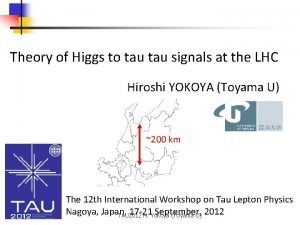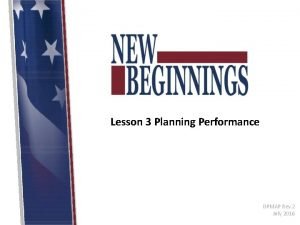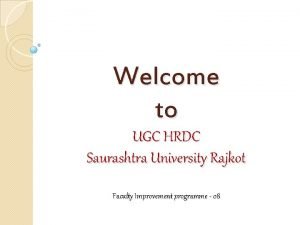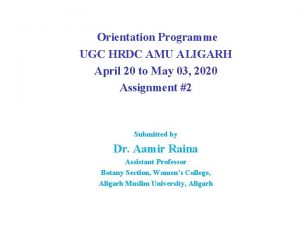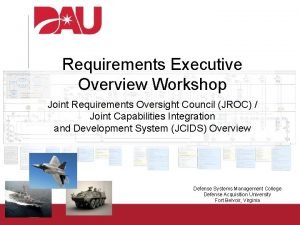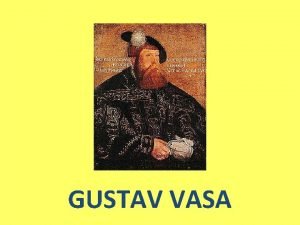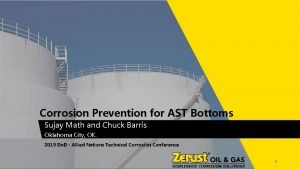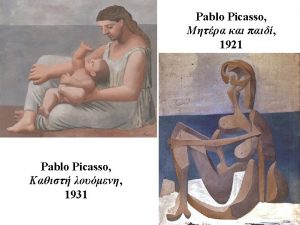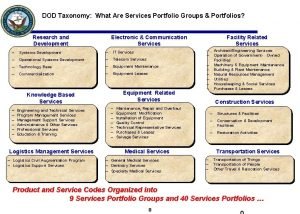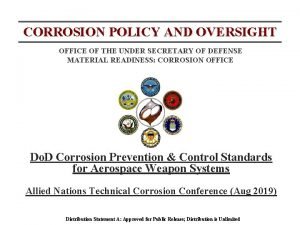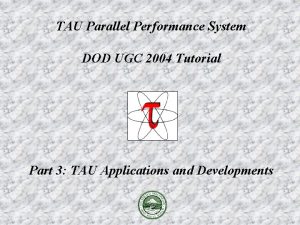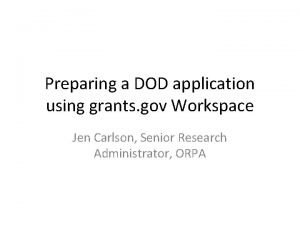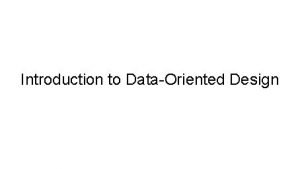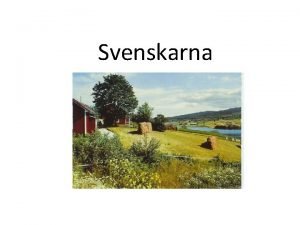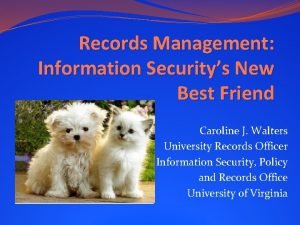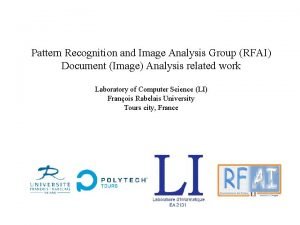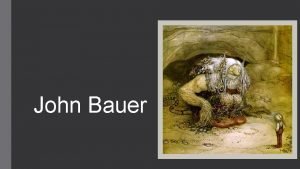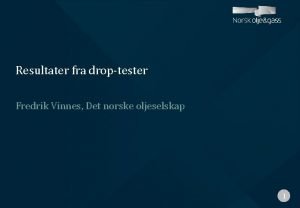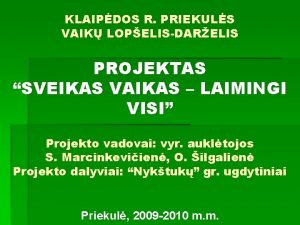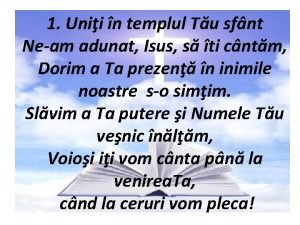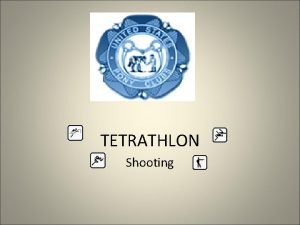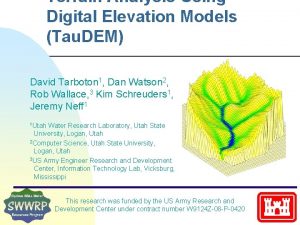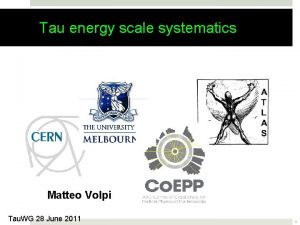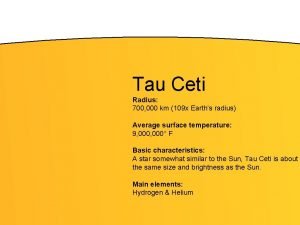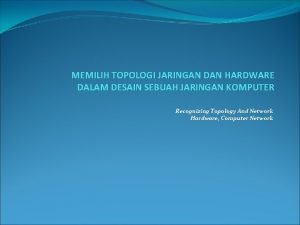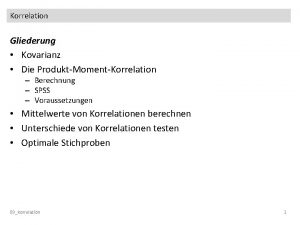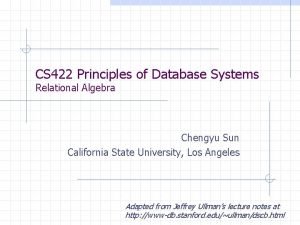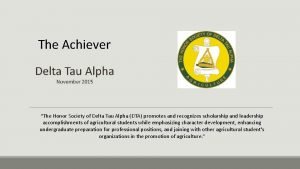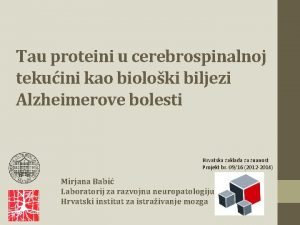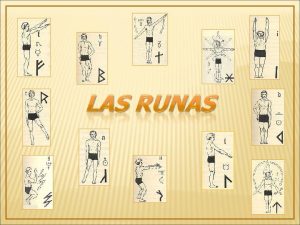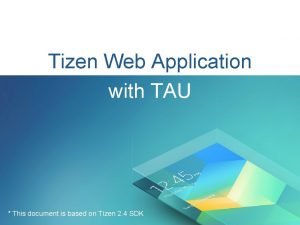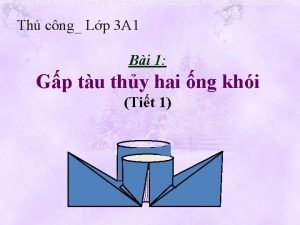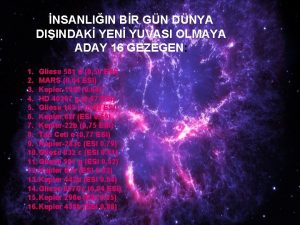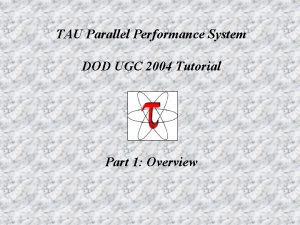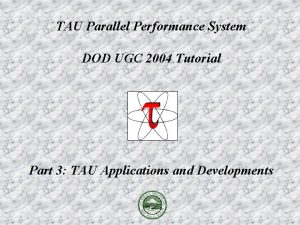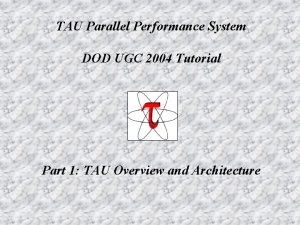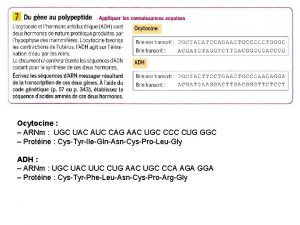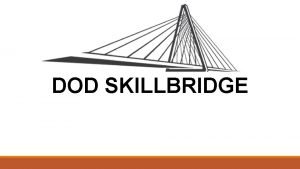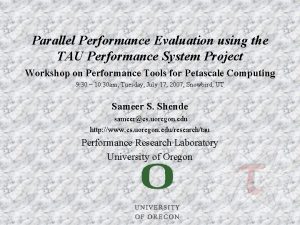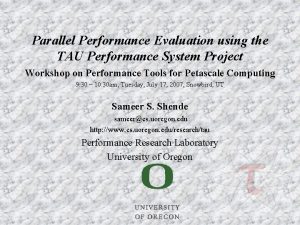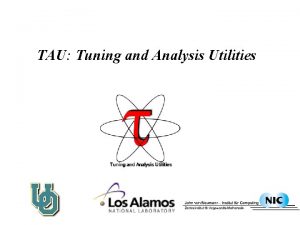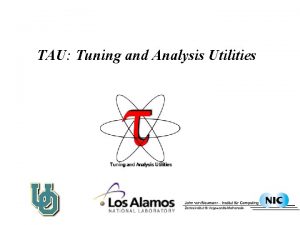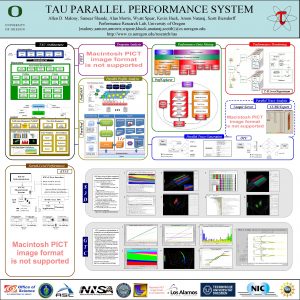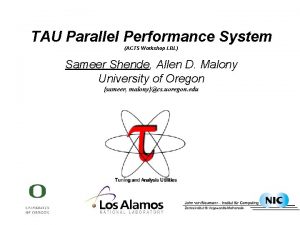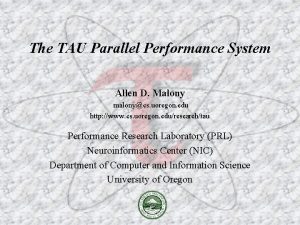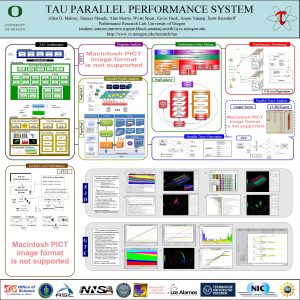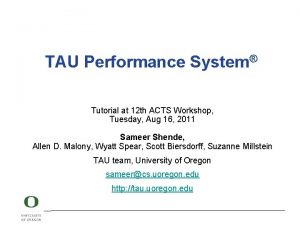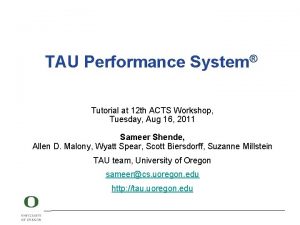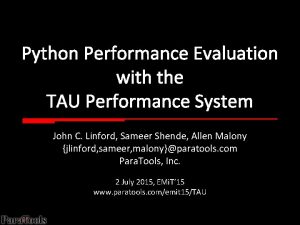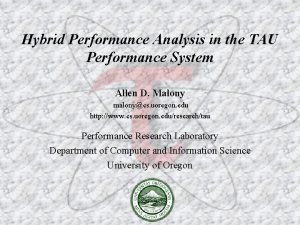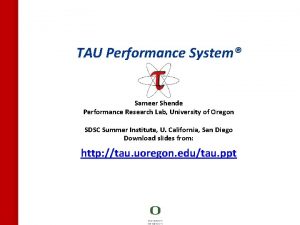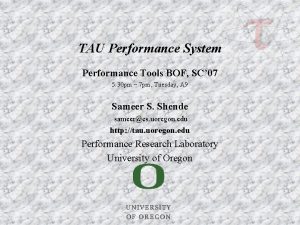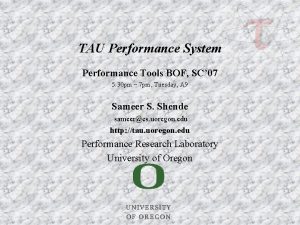TAU Parallel Performance System DOD UGC 2004 Tutorial







































![Pprof Command r pprof [-c|-b|-m|-t|-e|-i] [-r] [-s] [-n num] [-f file] [-l] [nodes] ¦ Pprof Command r pprof [-c|-b|-m|-t|-e|-i] [-r] [-s] [-n num] [-f file] [-l] [nodes] ¦](https://slidetodoc.com/presentation_image_h2/05b448b7431bef6ff2de7b8e0064ddc0/image-40.jpg)












- Slides: 52

TAU Parallel Performance System DOD UGC 2004 Tutorial Part 1: Overview

Outline r r Motivation Parallel performance complexity ¦ r r r r TAU System Components Examples Configuration Instrumentation Part 2: Using TAU Part 3: Case Studies Part 4: TAU Developments Conclusion TAU Parallel Performance System 2 DOD HPCMP UGC 2004

Research Motivation r Tools for performance problem solving ¦ ¦ Empirical-based performance optimization process Performance technology concerns Performance Technology • Experiment management • Performance database Performance Tuning hypotheses Performance Diagnosis properties Performance Experimentation characterization Performance Observation TAU Parallel Performance System 3 Performance Technology • Instrumentation • Measurement • Analysis • Visualization DOD HPCMP UGC 2004

Complex Parallel Systems r Complexity in computing system architecture ¦ Diverse parallel system architectures Ø shared ¦ ¦ r / distributed memory, cluster, hybrid, NOW, … Sophisticated processor and memory architectures Advanced network interface and switching architecture Complexity in parallel software environment ¦ Diverse parallel programming paradigms Ø shared ¦ ¦ ¦ memory multi-threading, message passing, hybrid Hierarchical, multi-level software architectures Optimizing compilers and sophisticated runtime systems Advanced numerical libraries and application frameworks TAU Parallel Performance System 4 DOD HPCMP UGC 2004

Complexity Challenges for Performance Tools r Computing system environment complexity ¦ ¦ r Observation integration and optimization Access, accuracy, and granularity constraints Diverse/specialized observation capabilities/technology Restricted modes limit performance problem solving Sophisticated software development environments ¦ ¦ ¦ Programming paradigms and performance models Performance data mapping to software abstractions Uniformity of performance abstraction across platforms Rich observation capabilities and flexible configuration Common performance problem solving methods TAU Parallel Performance System 5 DOD HPCMP UGC 2004

Performance Needs Performance Technology r Diverse performance observability requirements ¦ ¦ r Multiple levels of software and hardware Different types and detail of performance data Alternative performance problem solving methods Multiple targets of software and system application Demands more robust performance technology ¦ ¦ ¦ Broad scope of performance observation Flexible and configurable mechanisms Technology integration and extension Cross-platform portability Open, layered, and modular framework architecture TAU Parallel Performance System 6 DOD HPCMP UGC 2004

Parallel Performance Technology r Performance instrumentation tools ¦ ¦ r Performance measurement (observation) tools ¦ ¦ r Profiling and tracing of SW/HW performance events Different software (SW) and hardware (HW) levels Performance analysis tools ¦ r Different program code levels Different system levels Performance data analysis and presentation Online and offline tools Performance experimentation Performance modeling and prediction tools TAU Parallel Performance System 7 DOD HPCMP UGC 2004

Application Problem Domain r DOD defines leading edge parallel systems and software ¦ ¦ ¦ r Large-scale systems and heterogeneous platforms Multi-model simulation Complex, multi-layered software integration Multi-language programming Mixed-model parallelism Problem domain challenges ¦ ¦ System diversity demands tool portability Need for cross- and multi-language support Coverage of alternative parallel computation models Operate at scale TAU Parallel Performance System 8 DOD HPCMP UGC 2004

General Problems How do we create robust and ubiquitous performance technology for the analysis and tuning of parallel and distributed software and systems in the presence of (evolving) complexity challenges? How do we apply performance technology effectively for the variety and diversity of performance problems that arise in the context of complex parallel and distributed computer systems. TAU Parallel Performance System 9 DOD HPCMP UGC 2004

Definitions: Instrumentation r r Inserting extra code (hooks) into program Source code instrumentation ¦ ¦ r Object code instrumentation while program is running Pre-instrumented library ¦ r “Re-writing” the executable to insert hooks Dynamic code instrumentation ¦ r Manual Automatic by compiler or source-to-source translator Typically used for MPI and PVM program analysis Passive vs. active instrumentation TAU Parallel Performance System 10 DOD HPCMP UGC 2004

Definitions: Measurement r r Capturing performance data about system and software Triggered by events ¦ ¦ r r r Profile-based Trace-based Multiple performance data ¦ ¦ r Active and passive Obtain execution control to make measurement Execution time System and hardware statistics Runtime vs. online access TAU Parallel Performance System 11 DOD HPCMP UGC 2004

Definitions: Measurement – Profiling r Profiling ¦ Recording of summary information during execution Ø inclusive, ¦ exclusive time, # calls, hardware statistics, … Reflects performance behavior of program entities Ø functions, loops, basic blocks Ø user-defined “semantic” entities ¦ ¦ ¦ Very good for low-cost performance assessment Helps to expose performance bottlenecks and hotspots Implemented through Ø sampling: periodic OS interrupts or hardware counter traps Ø instrumentation: direct insertion of measurement code TAU Parallel Performance System 12 DOD HPCMP UGC 2004

Definitions: Measurement – Tracing r Tracing ¦ Recording data at significant points (events) Ø entering/exiting code region (function, loop, block, …) Ø thread/process interactions (e. g. , send/receive message) ¦ Save information in event record Ø timestamp Ø CPU identifier, thread identifier Ø Event type and event-specific information ¦ ¦ ¦ Event trace is a time-sequenced stream of event records Can be used to reconstruct dynamic program behavior Typically requires code instrumentation TAU Parallel Performance System 13 DOD HPCMP UGC 2004

Event Tracing: Instrumentation, Monitor, Trace Event definition CPU A: void master { trace(ENTER, 1); . . . trace(SEND, B); send(B, tag, buf); . . . trace(EXIT, 1); } timestamp MONITOR CPU B: void slave { trace(ENTER, 2); . . . recv(A, tag, buf); trace(RECV, A); . . . trace(EXIT, 2); } TAU Parallel Performance System 1 master 2 slave 3 . . . 58 A ENTER 1 60 B ENTER 2 62 A SEND B 64 A EXIT 1 68 B RECV A 69 B EXIT 2 . . . 14 DOD HPCMP UGC 2004

Event Tracing: “Timeline” Visualization 1 master 2 slave 3 . . . main master slave . . . 58 A ENTER 1 60 B ENTER 2 62 A SEND B 64 A EXIT 1 68 B RECV A 69 B EXIT 2 A B . . . TAU Parallel Performance System 58 60 62 64 66 68 70 15 DOD HPCMP UGC 2004

Unix Profiling Tools (prof) r r Classical Unix profiling tools: prof and gprof ¦ Sample-based measurement Ø Samples program counter (PC) at timer interrupts or traps Ø Match PC with code sections (routines) using symbol table ¦ Keeps time histogram Ø Assumes all time since last sample spent in routine Ø Accumulates time per routine ¦ ¦ Needs large enough samples to obtain statistical accuracy Requires program to be compiled for profiling Ø Need to produce symbol table TAU Parallel Performance System 16 DOD HPCMP UGC 2004

Unix Profiling Tools (gprof) r Interested in seeing routine calling relationships ¦ r Callpath profiling gprof ¦ Sample-based measurement Ø Samples program counter (PC) at timer interrupts or traps Ø Match PC with code sections (routines) using symbol table Ø Looks on stack for calling PC and matches to calling routine ¦ Keeps time histogram Ø Assumes all time since last sample spent in routine Ø Accumulates time per routine and caller Needs large enough samples to obtain statistical accuracy ¦ Requires program to be compiled for profiling ¦ TAU Parallel Performance System 17 DOD HPCMP UGC 2004

Performance API (PAPI, UTK) r Time is not the only thing of interest Access to hardware counters on modern microprocessors r papiprof r ¦ r Profiling using PAPI counter measurements Program Counter Library (PCL, Research Center Juelich) TAU Parallel Performance System 18 DOD HPCMP UGC 2004

What about Parallel Profiling? r Unix profiling tools are sequential profilers ¦ r Process-oriented What does parallel profiling mean? ¦ Capture profiles for all “threads of execution” Ø shared-memory threads for a process Ø multiple (Unix) processes ¦ What about interactions between “threads of execution”? Ø synchronization between threads Ø communication between processes ¦ ¦ r How to correctly save profiles for analysis? How to do the analysis and interpret results ? Parallel profiling scalability TAU Parallel Performance System 19 DOD HPCMP UGC 2004

MPI “Profiling” Interface (PMPI) r r How to capture message communication events? MPI standard defined an interface for instrumentation ¦ ¦ ¦ Alternative entry points to each MPI routine “Standard” routine entry linked to instrumented library Instrumented library performs measurement then calls alternative entry point for corresponding routine Ø library interposition Ø wrapper library r r r PMPI used for most MPI performance measurement PMPI also can be used for debugging PERUSE (LLNL) project is a follow-on project TAU Parallel Performance System 20 DOD HPCMP UGC 2004

Computation Model for Performance Technology r How to address dual performance technology goals? ¦ ¦ ¦ r Robust capabilities + widely available methods Contend with problems of system diversity Flexible tool composition/configuration/integration Approaches ¦ Restrict computation types / performance problems Ø machines, languages, instrumentation technique, … Ø limited performance technology coverage and application ¦ Base technology on abstract computation model Ø general architecture and software execution features Ø map features/methods to existing complex system types Ø develop capabilities that can be adapted and optimized TAU Parallel Performance System 21 DOD HPCMP UGC 2004

General Complex System Computation Model r Node: physically distinct shared memory machine ¦ r r Message passing node interconnection network Context: distinct virtual memory space within node Thread: execution threads (user/system) in context Interconnection Network physical view memory * Node VM space model view node memory … message * Inter-node communication Node SMP memory … Context TAU Parallel Performance System Threads 22 DOD HPCMP UGC 2004

TAU Performance System r r r Tuning and Analysis Utilities (12+ year project effort) Performance system framework for scalable parallel and distributed high-performance computing Targets a general complex system computation model ¦ ¦ ¦ r Integrated toolkit for performance instrumentation, measurement, analysis, and visualization ¦ ¦ r nodes / contexts / threads Multi-level: system / software / parallelism Measurement and analysis abstraction Portable performance profiling and tracing facility Open software approach with technology integration University of Oregon , Forschungszentrum Jülich, LANL TAU Parallel Performance System 23 DOD HPCMP UGC 2004

TAU Performance Systems Goals r Multi-level performance instrumentation ¦ r r Flexible and configurable performance measurement Widely-ported parallel performance profiling system ¦ ¦ r r r Computer system architectures and operating systems Different programming languages and compilers Support for multiple parallel programming paradigms ¦ r Multi-language automatic source instrumentation Multi-threading, message passing, mixed-mode, hybrid Support for performance mapping Support for object-oriented and generic programming Integration in complex software systems and applications TAU Parallel Performance System 24 DOD HPCMP UGC 2004

TAU Performance System Architecture Paraver TAU Parallel Performance System 25 EPILOG DOD HPCMP UGC 2004

Definitions: Instrumentation r Instrumentation ¦ ¦ Insertion of extra code (hooks) into program Source instrumentation Ø done by compiler, source-to-source translator, or manually + portable + links back to program code – re-compile is necessary for (change in) instrumentation – requires source to be available – hard to use in standard way for mix-language programs – source-to-source translators hard to develop (e. g. , C++, F 90) ¦ Object code instrumentation Ø “re-writing” TAU Parallel Performance System the executable to insert hooks 26 DOD HPCMP UGC 2004

Definitions – Instrumentation (continued) ¦ Dynamic code instrumentation Øa debugger-like instrumentation approach Ø executable code instrumentation on running program Ø Dyninst and DPCL are examples +/– opposite compared to source instrumentation ¦ Pre-instrumented library Ø typically used for MPI and PVM program analysis Ø supported by link-time library interposition + easy to use since only re-linking is necessary – can only record information about library entities TAU Parallel Performance System 27 DOD HPCMP UGC 2004

TAU Instrumentation Approach r Support for standard program events ¦ ¦ ¦ r Support for user-defined events ¦ ¦ ¦ r r r Routines Classes and templates Statement-level blocks Begin/End events (“user-defined timers”) Atomic events (e. g. , size of memory allocated/freed) Selection of event statistics Support definition of “semantic” entities for mapping Support for event groups Instrumentation optimization TAU Parallel Performance System 28 DOD HPCMP UGC 2004

TAU Instrumentation r Flexible instrumentation mechanisms at multiple levels ¦ Source code Ø manual Ø automatic C, C++, F 77/90/95 (Program Database Toolkit (PDT)) l Open. MP (directive rewriting (Opari), POMP spec) l ¦ Object code Ø pre-instrumented libraries (e. g. , MPI using PMPI) Ø statically-linked and dynamically-linked (e. g. , Python) ¦ Executable code Ø dynamic instrumentation (pre-execution) (Dyninst) Ø virtual machine instrumentation (e. g. , Java using JVMPI) TAU Parallel Performance System 29 DOD HPCMP UGC 2004

Multi-Level Instrumentation r Targets common measurement interface ¦ r Multiple instrumentation interfaces ¦ r Utilizes instrumentation knowledge between levels Selective instrumentation ¦ r Simultaneously active Information sharing between interfaces ¦ r TAU API Available at each level Cross-level selection Targets a common performance model Presents a unified view of execution ¦ Consistent performance events TAU Parallel Performance System 30 DOD HPCMP UGC 2004

Code Transformation and Instrumentation r Program information flows through stages of compilation/linking/execution ¦ ¦ r Different information is accessible at different stages Each level poses different constraints and opportunities for extracting information Where should performance instrumentation be done? ¦ ¦ ¦ At what level? Instrumentation at different levels Cooperative TAU Parallel Performance System 31 DOD HPCMP UGC 2004

Code Transformation Levels and Instrumentation relevant to code aspects instrumentation source code preprocessor source code r Capture knowledge of code relationships compiler object code Relate performance data to sourcelevel view instrumentation libraries linker executable r instrumentation OS runtime image instrumentation VM instrumentation run Performance Data TAU Parallel Performance System 32 DOD HPCMP UGC 2004

TAU Source Instrumentation r Automatic source instrumentation (tau_instrumentor) ¦ ¦ ¦ Routine entry/exit and class method entry/exit Block entry/exit and statement level (to be added) Uses an instrumentation specification file Ø Include/exclude ¦ r list for events and files Uses command line options for group selection Instrumentation event selection (tau_select) ¦ ¦ Automatic generation of instrumentation specification file Instrumentation language to describe event constraints Ø Event identity and location Ø Event performance properties (e. g. , overhead analysis) ¦ Create TAUselect scripts for performance experiments TAU Parallel Performance System 33 DOD HPCMP UGC 2004

TAU Performance Measurement r r r TAU supports profiling and tracing measurement Robust timing and hardware performance support Support for online performance monitoring ¦ ¦ r Extension of TAU measurement for multiple counters ¦ ¦ r r Profile and trace performance data export to file system Selective exporting Creation of user-defined TAU counters Access to system-level metrics Support for callpath measurement Integration with system-level performance data ¦ Operating system statistics (e. g. , /proc file system) TAU Parallel Performance System 34 DOD HPCMP UGC 2004

TAU Measurement r Performance information ¦ ¦ Performance events High-resolution timer library (real-time / virtual clocks) General software counter library (user-defined events) Hardware performance counters Ø PAPI (Performance API) (UTK, Ptools Consortium) Ø consistent, portable API r Organization ¦ ¦ ¦ Node, context, thread levels Profile groups for collective events (runtime selective) Performance data mapping between software levels TAU Parallel Performance System 35 DOD HPCMP UGC 2004

TAU Measurement with Multiple Counters r Extend event measurement to capture multiple metrics ¦ ¦ ¦ r Begin/end (interval) events User-defined (atomic) events Multiple performance data sources can be queried Associate counter function list to event ¦ ¦ Defined statically or dynamically Different counter sources Ø Timers and hardware counters Ø User-defined counters (application specified) Ø System-level counters ¦ r Monotonically increasing required for begin/end events Extend user-defined counters to system-level counter TAU Parallel Performance System 36 DOD HPCMP UGC 2004

TAU Measurement Options r Parallel profiling ¦ ¦ ¦ r Tracing ¦ ¦ ¦ r Function-level, block-level, statement-level Supports user-defined events TAU parallel profile data stored during execution Hardware counts values and support for multiple counters Support for callgraph and callpath profiling All profile-level events Inter-process communication events Trace merging and format conversion Configurable measurement library TAU Parallel Performance System 37 DOD HPCMP UGC 2004

Grouping Performance Data in TAU r Profile Groups ¦ ¦ A group of related routines forms a profile group Statically defined Ø TAU_DEFAULT, TAU_IO, … ¦ TAU_USER[1 -5], TAU_MESSAGE, Dynamically defined Ø group name based on string, such as “mpi” or “particles” Ø runtime lookup in a map to get unique group identifier Ø uses tau_instrumentor to instrument ¦ ¦ Ability to change group names at runtime Group-based instrumentation and measurement control TAU Parallel Performance System 38 DOD HPCMP UGC 2004

Performance Analysis and Visualization r r Analysis of parallel profile and trace measurement Parallel profile analysis ¦ ¦ ¦ r r Performance data management framework (Perf. DMF) Parallel trace analysis ¦ ¦ ¦ r Pprof : parallel profiler with text-based display Para. Prof : graphical, scalable parallel profile analysis Para. Vis : profile visualization Format conversion (ALOG, VTF 3. 0, Paraver, EPILOG) Trace visualization using Vampir (Pallas/Intel) Parallel profile generation from trace data Online parallel analysis and visualization TAU Parallel Performance System 39 DOD HPCMP UGC 2004
![Pprof Command r pprof cbmtei r s n num f file l nodes Pprof Command r pprof [-c|-b|-m|-t|-e|-i] [-r] [-s] [-n num] [-f file] [-l] [nodes] ¦](https://slidetodoc.com/presentation_image_h2/05b448b7431bef6ff2de7b8e0064ddc0/image-40.jpg)
Pprof Command r pprof [-c|-b|-m|-t|-e|-i] [-r] [-s] [-n num] [-f file] [-l] [nodes] ¦ -c Sort according to number of calls ¦ -b Sort according to number of subroutines called ¦ -m Sort according to msecs (exclusive time total) ¦ -t Sort according to total msecs (inclusive time total) ¦ -e Sort according to exclusive time per call ¦ -i Sort according to inclusive time per call ¦ -v Sort according to standard deviation (exclusive usec) ¦ -r Reverse sorting order ¦ -s Print only summary profile information ¦ -n num Print only first number of functions ¦ -f file Specify full path and filename without node ids ¦ -l List all functions and exit TAU Parallel Performance System 40 DOD HPCMP UGC 2004

Pprof Output (NAS Parallel Benchmark – LU) r r Intel Quad PIII Xeon F 90 + MPICH Profile - Node - Context - Thread Events - code - MPI TAU Parallel Performance System 41 DOD HPCMP UGC 2004

Profile Terminology – Example r r Routine “int main( )” Inclusive time ¦ r 100 -20 -50 -20=10 secs 1 call #Subrs ¦ ¦ r f 1(); /* takes 20 secs */ f 2(); /* takes 50 secs */ f 1(); /* takes 20 secs */ #Calls ¦ r 100 secs Exclusive time ¦ r int main( ) { /* takes 100 secs */ Child routines called 3 Inclusive time/call ¦ /* other work */ } /* Time can be replaced by */ counts 100 secs TAU Parallel Performance System 42 DOD HPCMP UGC 2004

Para. Prof (NAS Parallel Benchmark – LU) node, context, thread Global profiles Routine profile across all nodes Event legend Individual profile TAU Parallel Performance System 43 DOD HPCMP UGC 2004

TAU + Vampir (NAS Parallel Benchmark – LU) Timeline display Callgraph display Parallelism display Communications display TAU Parallel Performance System 44 DOD HPCMP UGC 2004

Semantic Performance Mapping user-level and domain-level abstractions instrumentation source code preprocessor source code instrumentation compiler object code libraries linker executable Associate performance measurements with high-level semantic abstractions TAU Parallel Performance System instrumentation OS runtime image instrumentation VM instrumentation run Performance Data 45 DOD HPCMP UGC 2004

TAU Performance System Status r Computing platforms (selected) ¦ r Programming languages ¦ r C, C++, Fortran 77/90/95, HPF, Java, Open. MP, Python Thread libraries ¦ r IBM SP / p. Series, SGI Origin 2 K/3 K, Cray T 3 E / SV-1 / X 1, HP (Compaq) SC (Tru 64), Sun, Hitachi SR 8000, NEC SX-5/6, Linux clusters (IA-32/64, Alpha, PPC, PARISC, Power, Opteron), Apple (G 4/5, OS X), Windows pthreads, SGI sproc, Java, Windows, Open. MP Compilers (selected) ¦ Intel KAI (KCC, KAP/Pro), PGI, GNU, Fujitsu, Sun, Microsoft, SGI, Cray, IBM (xlc, xlf), Compaq, NEC, Intel TAU Parallel Performance System 46 DOD HPCMP UGC 2004

Selected Applications of TAU r Center for Simulation of Accidental Fires and Explosion ¦ ¦ r Center for Simulation of Dynamic Response of Materials ¦ ¦ r University of Utah, ASCI ASAP Center, C-SAFE Uintah Computational Framework (UCF) (C++) California Institute of Technology, ASCI ASAP Center Virtual Testshock Facility (VTF) (Python, Fortran 90) Los Alamos National Lab ¦ Monte Carlo transport (MCNP) (Susan Post) Ø Full code automatic instrumentation and profiling Ø ASCI Q validation and scaling ¦ SAIC’s Adaptive Grid Eulerian (SAGE) (Jack Horner) Ø Fortran 90 automatic instrumentation and profiling TAU Parallel Performance System 47 DOD HPCMP UGC 2004

Selected Applications of TAU (continued) r Lawrence Livermore National Lab ¦ ¦ Overture object-oriented PDE package (C++) Radiation diffusion (KULL) Ø C++ r Sandia National Lab ¦ ¦ ¦ r automatic instrumentation, callpath profiling DOE CCTTSS Sci. DAC project Common component architecture (CCA) integration Combustion code (C++, Fortran 90, Gr. ACE, MPI) Center for Astrophysical Thermonuclear Flashes ¦ ¦ University of Chicago / Argonne, ASCI ASAP Center FLASH code (C, Fortran 90, MPI) TAU Parallel Performance System 48 DOD HPCMP UGC 2004

Selected Applications of TAU (continued) r Argonne National Lab ¦ PETSc Ø Portable, r Extensible Toolkit for Scientific Comptuation National Center for Atmospheric Research (NCAR) ¦ ¦ University Corporation for Atmospheric Research (UCAR) Earth System Modeling Framework (ESMF) TAU Parallel Performance System 49 DOD HPCMP UGC 2004

Concluding Remarks Complex parallel systems and software pose challenging performance analysis problems that require robust methodologies and tools r To build more sophisticated performance tools, existing proven performance technology must be utilized r Performance tools must be integrated with software and systems models and technology r Performance engineered software ¦ Function consistently and coherently in software and system environments ¦ r TAU performance system offers robust performance technology that can be broadly integrated TAU Parallel Performance System 50 DOD HPCMP UGC 2004

Supporting Agencies r Department of Energy (DOE) ¦ Office of Advanced Scientific Computing Research (OASCR), MICS Division Ø DOE 2000 ACTS contract Ø “Performance Technology for Tera-class Parallel Computer Systems: Evolution of the TAU Performance System” Ø “Performance Analysis of Parallel Component Software” ¦ National Nuclear Security Administration (NNSA), Office of Advanced Simulation and Computing (ASC) Ø University of Utah DOE ASCI Level 1 sub- contract Ø DOE ASCI Level 3 (LANL, LLNL) TAU Parallel Performance System 51 DOD HPCMP UGC 2004

Supporting (continued) r National Science Foundation ¦ r NSF National Young Investigator (NYI) award Research Centre Juelich ¦ ¦ John von Neumann Institute for Computing Dr. Bernd Mohr r Los Alamos National Laboratory r University of Oregon TAU Parallel Performance System 52 DOD HPCMP UGC 2004
 Higgs to tau tau
Higgs to tau tau Dpmap performance elements and standards examples
Dpmap performance elements and standards examples Hrdc rajkot
Hrdc rajkot Jhu
Jhu Qaa certified meaning in nepali
Qaa certified meaning in nepali Functions of ugc
Functions of ugc Hrdc.amu
Hrdc.amu How did juda die
How did juda die Dod cio organization chart
Dod cio organization chart Gustav vasa barndom
Gustav vasa barndom Dod evmig
Dod evmig Article of the code of conduct
Article of the code of conduct Dod patient safety program
Dod patient safety program Dod digital engineering strategy
Dod digital engineering strategy 2019 dod allied nations technical corrosion conference
2019 dod allied nations technical corrosion conference Fss muni percentil posledního přijatého
Fss muni percentil posledního přijatého Picasso dod
Picasso dod Dod taxonomy
Dod taxonomy Mil-std-889d
Mil-std-889d Dod
Dod Dod workspace
Dod workspace Oop vs dod
Oop vs dod Ralph lundsten död
Ralph lundsten död Dod gemcar
Dod gemcar Caroline zier dod
Caroline zier dod Dod logo
Dod logo Krister bauer
Krister bauer Whakataka te hau
Whakataka te hau Kia tau kia tatou katoa karakia
Kia tau kia tatou katoa karakia Elastisk tau biltema
Elastisk tau biltema Labas rytas tau galvyte
Labas rytas tau galvyte Uniti in templul tau sfant versuri
Uniti in templul tau sfant versuri Tetrathlon gun
Tetrathlon gun Tau dem
Tau dem Tau energi
Tau energi Tau ceti distance to earth
Tau ceti distance to earth Pilih topologi atau desain jaringan yang kamu tau
Pilih topologi atau desain jaringan yang kamu tau Punktbiseriale korrelation
Punktbiseriale korrelation Ksi letra grega
Ksi letra grega Delta relational algebra
Delta relational algebra Letra tau hebrea
Letra tau hebrea Delta tau alpha honor society
Delta tau alpha honor society Tau proteini
Tau proteini Tau beta sigma preamble
Tau beta sigma preamble Tali ui sepitema
Tali ui sepitema Tyr runa
Tyr runa Tizen tau
Tizen tau Gấp tàu thủy hai ống khói
Gấp tàu thủy hai ống khói Sen tau
Sen tau Tau ceti e
Tau ceti e Poet provensal felix
Poet provensal felix Leyenda en prosa
Leyenda en prosa Tau tangles
Tau tangles
